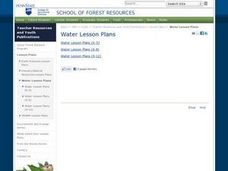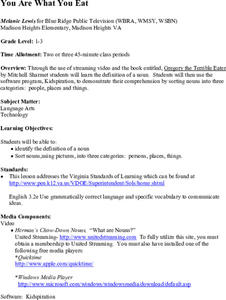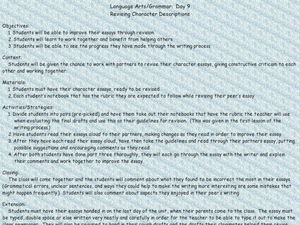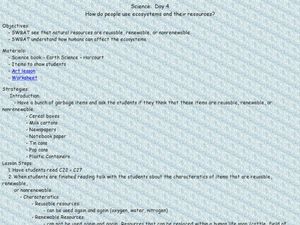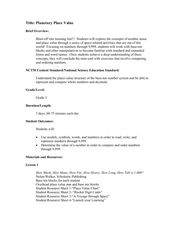Curated OER
"Pennsylvania Watersheds, Many Ways to the Sea"
Students trace a molecule of water through the water cycle including each of its three loops. They describe why evapotranspiration demands the largest portion of total precipitation falling on a forested watershed.
Curated OER
Turn Off That TV!
To honor Screen Free Week, how can you challenge your class to turn off the TV May 5-11, 2014?
Curated OER
Seeing is Believing - Or Is It?
Here is a great science lesson. It extends the concept of vision into the area of optical illusions, perspective, and tessellation. This well-designed plan has tons of great activities, utilizes interesting video, and should lead to a...
Curated OER
You Are What You Eat
Youngsters listen to the story of Gregory the Terrible Eater and write a similar story using the same pattern. In the new book, Herman is requested to eat things that are nouns. They must supply the correct part of speech for the class...
Curated OER
Working Together
Students work together to solve problems. In this math lesson, students apply math skills of graphing to work on an assignment together and at the same time, learn to problem solve. They walk away learning to work well in groups.
Curated OER
Wax Resist Fish
Students review what a pattern is and they create a pattern on a fish. They are reminded that patterns do not change halfway through and they paint over it with watercolor paints. They display their fish on the walls.
Curated OER
Revising Character Descriptions
Learners effectively revise character descriptions. In this revising character descriptions lesson, students work with a partner to give and receive constructive criticism to improve their character descriptions.
Curated OER
4 Step Approach to Problem Solving
Students explore problem solving. In this middle school mathematics instructional activity, students investigate the four-step approach to problem solving. Students solve word problems by employing the four-step process and...
Curated OER
How do people use ecosystems and their resources?
Young scholars examine how natural resources are reusable, renewable or nonrenewable. In this ecosystems lesson students see the effects humans have on ecosystems and complete an art lesson activity.
Curated OER
Friendship
Middle schoolers identify qualities of a friend and discover an acronym to help with problem solving. In this friendship instructional activity, students use notecards to identify qualities of a friend and write a...
Curated OER
Economies
Students discover different economic systems. In this global economy instructional activity, students research the levels of economic activity, types of economies, maquiladoras and the differences between a free market economy and other...
Curated OER
Topic: Military/ Defense
Students examine ancient military systems. In this history of defense lesson, students research the weapons employed defending ancient cities and territories. Students describe how they would defend themselves following a plane wreck...
Curated OER
Beautiful Bugs
Students investigate the life cycle of ants, ladybugs, and butterflies. They list the four stages of the butterfly life cycle, define symmetry and observe how ants make homes in dirt.
Curated OER
Here's the Pitch
Students define pitch, measure varying amounts of water into containers, make predictions about the sounds made when striking the containers, put containers in order from highest to lowest pitch, and create their own sound patterns with...
Curated OER
Washing Germs Away
Students investigate germs. In this cross curriculum health and biology lesson plan, students listen to Old Black Fly by Jim Aylesworth and identify ways in which flies spread germs. Students discuss hand washing during a visit by the...
Curated OER
Gardens Under the Sea: Coral Reefs
Students, with dive partners, explore coral reefs through scuba diving. They also explore radial symmetry and bilateral symmetry.
Curated OER
Horns or Antlers-You Decide!
Students study the difference between horns and antlers. They identify animals who have each and draw pictures of these animals. They experience samples of actual horns and antlers.
Curated OER
Let's Get Carried Away
Students discover how seeds travel from their parent plants in search of water, sunlight, and nutrients, and conduct experiments in which they note characteristics that encourage seed dispersal by means of wind, water, animal carriers,...
Curated OER
Would You Believe Your Eyes?
Students study the parts and functions of the human eye. They create dodecagons which are twelve-sided figures with twelve equal angles and share these with the class so that each student can begin to see how many different illusions can...
Curated OER
Gateway to America
Fifth graders study about immigration, Ellis Island, and tenement life from 1890 to 1924. They create an identity of a fictitious immigrant and describe what they find when they arrive in New York.
Curated OER
Immigrants: Yester and Today
Seventh graders brainstorm ideas why it is necessary to have a Resident Alien Id card. They complete a KWL chart on what they know about immigrants.
Curated OER
Planetary Place Value
Third graders explore place value to the ten thousands place. This incredibly thorough, 24-page lesson has learners construct, order, and compare numbers to 9,999. This three-day lesson includes reteaching and extension activities...
Curated OER
Junk Food Jungle
Students become familiar with the nutritional value of foods advertised on television and in magazines. They discuss different types of foods and where snack food fits into a healthy diet. They categorize the foods they eat as healthy or...
Curated OER
Nurturing Green Thumbs at School
Incorporating a school garden into the curriculum cultivates many benefits.
